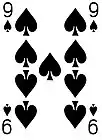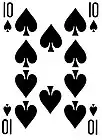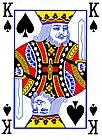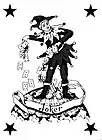四
| ||||||||
Translingual
| Stroke order | |||
|---|---|---|---|
 | |||
Han character
四 (radical 31, 囗+2, 5 strokes, cangjie input 田金 (WC), four-corner 60210, composition ⿴囗⿰丿㇄(GHTV) or ⿴囗儿(JK))
References
- KangXi: page 216, character 22
- Dai Kanwa Jiten: character 4682
- Dae Jaweon: page 439, character 21
- Hanyu Da Zidian: volume 1, page 710, character 16
- Unihan data for U+56DB
Chinese
| simp. and trad. |
四 | |
|---|---|---|
| variant forms | ||
Glyph origin
| Historical forms of the character 四 | |||||||||
|---|---|---|---|---|---|---|---|---|---|
| Shang | Western Zhou | Spring and Autumn | Warring States | Shuowen Jiezi (compiled in Han) | Liushutong (compiled in Ming) | ||||
| Bronze inscriptions | Oracle bone script | Bronze inscriptions | Bronze inscriptions | Bronze inscriptions | Chu Slip and silk script | Qin slip script | Ancient script | Small seal script | Transcribed ancient scripts |
 |
 |
 |
 |
 |
 |
 |
 |
 |
 |
| Characters in the same phonetic series (四) (Zhengzhang, 2003) | |
|---|---|
| Old Chinese | |
| 訵 | *l̥ʰids |
| 四 | *hljids |
| 泗 | *hljids |
| 駟 | *hljids |
| 柶 | *hljids |
| 牭 | *hljids |
| 呬 | *hrids |
The word "four" was written as 亖 before Western Zhou and 四 appeared in late Spring and Autumn period. This alternative form was used to prevent confusion of 亖 and 二 or 三 in vertical writing. It was standardized in Qin dynasty.
The bronzeware style of the character featured a repositioning of those four lines inside 口; this later evolved into the combination used today of 口 (“mouth”) and 八 (“divide”) which meant a dispersal of breath. It could thus be said that four is a borrowed meaning for this character. The original sense is preserved in 呬 (OC *hrids), by adding an extra 口.
Etymology
From Proto-Sino-Tibetan *b-ləj.
Pronunciation
Definitions
四
Usage notes
As superstition, 四 (MC siɪH) is avoided because it is similar to 死 (MC sˠiɪX, “death”) in sound.
Compounds
|
|
|
Descendants
Others:
See also
| Chinese numbers | ||||||||||||||||
|---|---|---|---|---|---|---|---|---|---|---|---|---|---|---|---|---|
| 0 | 1 | 2 | 3 | 4 | 5 | 6 | 7 | 8 | 9 | 10 | 102 | 103 | 104 | 108 | 1012 | |
| Normal (小寫/小写) |
〇 | 一 | 二 | 三 | 四 | 五 | 六 | 七 | 八 | 九 | 十 | 百 | 千 | 萬/万 | 億/亿 | 兆 (Taiwan) 萬億/万亿 (Mainland China) |
| Financial (大寫/大写) |
零 | 壹 | 貳/贰 | 參/叁 | 肆 | 伍 | 陸/陆 | 柒 | 捌 | 玖 | 拾 | 佰 | 仟 | |||
| Playing cards in Chinese · 撲克牌/扑克牌 (pūkèpái) (layout · text) | ||||||
|---|---|---|---|---|---|---|
| A | 二 | 三 | 四 | 五 | 六 | 七 |
 |
 |
 |
 |
 |
 |
 |
| 八 | 九 | 十 | J | Q | K | 小王 (black), 大王 (red) |
Japanese
| < 3 | 4 | 5 > |
|---|---|---|
| Cardinal : 四 | ||
Readings
Compounds
Derived terms
- 四捨五入 (shishagonyū): rounding (fractions)
- 四則演算 (shisokuenzan): the four basic arithmetic operations
- 四天王 (shitennō): the Four Heavenly Kings (Buddhism)
- 四面楚歌 (shimensoka): facing hostility, difficulty, or frustration on all sides
Etymology 1
/yo2/ *[jə] > /yo/ [jo].
Etymology 2
Native 四 (yo, “four”) + n, influenced by analogy by the final sound in Chinese 三 (san, “three”).
Etymology 3
Sino-Japanese reading.
Coordinate terms
| Japanese numbers | |||||||||||
|---|---|---|---|---|---|---|---|---|---|---|---|
| 0 | 1 | 2 | 3 | 4 | 5 | 6 | 7 | 8 | 9 | 10 | |
| Regular | 零 (rei) 零 (zero) |
一 (ichi) | 二 (ni) | 三 (san) | 四 (yon) 四 (shi) |
五 (go) | 六 (roku) | 七 (nana) 七 (shichi) |
八 (hachi) | 九 (kyū) 九 (ku) |
十 (jū) |
| Formal | 壱 (ichi) | 弐 (ni) | 参 (san) | 拾 (jū) | |||||||
| 90 | 100 | 300 | 600 | 800 | 1,000 | 3,000 | 8,000 | 10,000 | 100,000,000 | ||
| Regular | 九十 (kyūjū) | 百 (hyaku) 一百 (ippyaku) |
三百 (sanbyaku) | 六百 (roppyaku) | 八百 (happyaku) | 千 (sen) 一千 (issen) |
三千 (sanzen) | 八千 (hassen) | 一万 (ichiman) | 一億 (ichioku) | |
| Formal | 一萬 (ichiman) | ||||||||||
| 1012 | 8×1012 | 1013 | 1016 | 6×1016 | 8×1016 | 1017 | 1018 | ||||
| 一兆 (itchō) | 八兆 (hatchō) | 十兆 (jutchō) | 一京 (ikkei) | 六京 (rokkei) | 八京 (hakkei) | 十京 (jukkei) | 百京 (hyakkei) | ||||
References
- The Japan Times (March 17, 2010). You can count on the tales behind number-kanji. Accessed March 23, 2010.
Mulam
Vietnamese
References
- Nguyễn (2014).
- Nguyễn et al. (2009).
- Trần (2004).
- Hồ (1976).